Advancements in NMDA Receptor-Targeted Antidepressants: From d-Cycloserine Discovery to Preclinical Efficacy of Lu AF90103.
Ascic, E., Marigo, M., David, L., Frisch Herrik, K., Grupe, M., Hougaard, C., Mork, A., Jones, C.R., Badolo, L., Frederiksen, K., Boonen, H.C.M., Jensen, H.S., Kilburn, J.P.(2024) J Med Chem 67: 20135-20155
- PubMed: 39560374
- DOI: https://doi.org/10.1021/acs.jmedchem.4c01477
- Primary Citation of Related Structures:
9GIB, 9GIC, 9GID, 9GIE, 9GIF, 9GIG, 9GJ1 - PubMed Abstract:
The discovery of d-cycloserine ( DCS ), a partial agonist of the NMDA receptor that exhibits antidepressant effects without the psychotomimetic effects of ketamine, has fueled interest in new NMDA-targeting antidepressants. Our objective was to identify potent partial agonists mirroring DCS , particularly tailored for the GluN2B subtype of the NMDA receptor. Through a structure-based drug design approach, we discovered compound 42d . This compound acts as a partial agonist of the GluN1/GluN2B complex, exhibiting 24% efficacy, and has an EC 50 value of 78 nM. Subsequent investigations led us to 42e (Lu AF90103), a methyl ester prodrug of 42d capable of penetrating the blood-brain barrier, as confirmed by rat microdialysis studies. In different rat in vivo models relevant to neuropsychiatric diseases, administering 42e led to 42d demonstrating both acute effects, observed in a seizure model and EEG, and lasting effects in the stress-sensitive hippocampal pathway and an antidepressant-sensitive model.
- Neuroscience Drug Discovery Denmark, H. Lundbeck A/S, 9 Ottiliavej, Valby, DK-2500 Copenhagen, Denmark.
Organizational Affiliation:


















